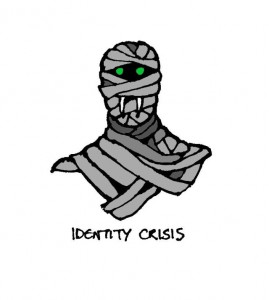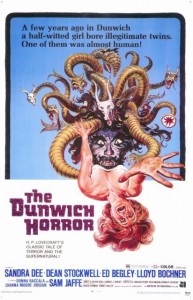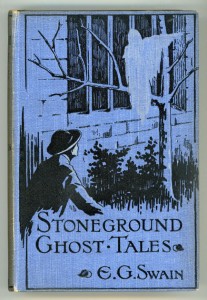I think it’s fair to say that if you are called Hesketh Vernon Hesketh-Prichard (1876-1922) and nicknamed ‘Hex’ at school, you ought to do something interesting with your life.
The fascinating HVH-P did not let anyone down. He hunted for (probably) extinct giant sloths in South America, helped counter German snipers on the Great War, played a mean game of cricket and explored the world. Through Trackless Labrador is one of his, for example, and he is supposed to have brought back some of the first reports of vodoun from the interior of Haiti. He could have been invented for the Boy’s Own Library.
And he loved his mum. At least, I presume he did, because with his mother Kate O’Brien Ryall Prichard, he wrote a series of occult detective stories. She also accompanied him on some of his travels, but that’s another matter.
The Flaxman Low adventures were attributed to E and H Heron, probably because the printers couldn’t fit both their full names on the covers. Published 1898-99, there were twelve stories in total, stories which brought his character onto the occult detective roll of honour. These tales are interesting, unusual and come with a twist of the new science of psychology (these are the 1890s, remember). But wait…
I had intended to write my usual gentle introductory ramble. Then I re-read the Heron family this summer, and realised that this stuff is, in fact, nuts. Enjoyable, but nuts.
The detective himself is “one of the leading scientists of the day”, whose real name is not disclosed. He is also an accomplished sportsman, and a record-breaking hammer-thrower, strong and lean with a high forehead, long neck and thin moustache. We learn this early on, which gets us all a-quiver and ready for the horrors.
And boy did I have trouble picking which horrors to feature here. So much gold in the river. I have rarely felt so dumbfounded when I put a book down. Here are two of Flaxman Low’s discoveries, to give you the idea:
- A dead black servant found mouldering in a tiny cupboard in a Scottish manor house, after growing poisonous fungi, derived from deadly African spores, in there. Helpfully we are told: “how or why he made use of them are questions that can never be cleared up now”.
- A ghost which eventually turns into a vampire which decides to inhabit the remains of an Egyptian mummy. As an extra, the ghost/vampire/mummy may have come originally from an ancient English barrow-mound. It’s like the entire Hammer Horror catalogue in twelve pages.
I do wish I had thought of these.
 Flaxman Low the Man has a number of noble characteristics, apart from his high forehead.
Flaxman Low the Man has a number of noble characteristics, apart from his high forehead.
Firstly, he attributes his findings to his advanced knowledge of psychology and study of psychic manifestations. When he can’t really answer someone’s question, he replies:
“Everybody who…. investigates the phenomena of spiritism will, sooner or later, meet in them some perplexing element, which is not to be explained by any of the ordinary theories. For reasons into which I need not now enter, this present case appears to me to be one of these.”
A wonderful paragraph, which in my own humbler stories would have been rendered thus:
Inspector Chiltern: What was that, then?
Henry: Haven’t the faintest, old chap.
Secondly, he decides for quite unknown reasons to put everyone in danger (except himself) by declaring halfway through most stories that he has pretty much solved the case but won’t give them the answer until lots more harm has been done. I felt very Miss Marple sometimes, even at the end:
“But Aunt Jane, you still haven’t explained how the one-armed werewolf which killed Colonel Smythe knew that the spectral squid would be blamed…”
Thirdly, he likes burning/shooting/knocking things down as a quick end to the matter. If he had been written with a touch more Indiana Jones, the stories would be perfect. I feel I have to commend to you the final scene with the barrow-wight/ghost/vampire/mummy, in which it is despatched by putting the bullet-riddled and beaten remains into a boat and giving them a Viking funeral. You couldn’t make this up – except the Heron family did.
To finish this piece I want to ruin one particular tale in more detail, to illustrate the general approach. The Story of the Spaniards, Hammersmith is the first Low appearance. It starts with the traditional motif of Flaxman Low being called in by a chum. The chum has inherited a house, and surprisingly, the house can’t be let for long because the tenants run away or shoot out the skirting boards (I’m serious). Financially embarrassed, the chum asks for help, and…
The story is wonderful, especially as it veers into Lovecraft before Lovecraft in its descriptions:
“The sensation he experienced as it moved was of some ponderous, pulpy body, not crawling or creeping, but spreading… then he became conscious of a pair of glassy eyes, with livid, everted lids, looking into his own… they were watery, like the eyes of a dead fish, and gleamed with a pale, internal lustre.”
This description follows the sighting of a bladder-like object regularly going into one of the rooms, but never to be found when pursued. “The bladder-like object may be the key to the mystery.” Low pronounces before any real investigation has started. There’s a detective for you.
After a simple experiment, Low decides (on thin evidence) that a leprous curmudgeon died in the house, and is haunting it. Flaxman Low has a novel solution – they pull the house down. In doing so they find a malformed skeleton “under the boarding at an angle of the landing”. Low reveals that the leper’s spirit has been intermittently animating its remains, at which point I knelt before Hesketh Vernon Hesketh Pritchard (and his mum) in awe.
You see, the bladder object was a bandaged, leprous foot, strangely visible when the rest of the body was not; marks on a landing deliberately strewn with sand (a common psychologist trick) were caused by walking sticks – lame ghost, apparently; the spirit had somehow become huge and pulpy despite animating a wrecked skeleton, and anyway, the leprous chap who could hardly move had for some reason hidden himself ingeniously under the landing floorboards before he died!
Wow. I so got it.
And there you have him, Flaxman Low, the occult detective with a difference. You have been warned…


